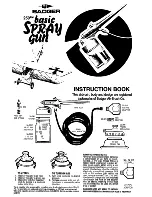
EN
150
EN
151
SAFETY INSTRUCTIONS FOR BAT-
TERY
1.
Never use a damaged battery.
2.
Do not open the battery. There is a
risk of a short-circuit.
3.
Protect the battery from heat, e.g.
from continuous exposure to sun-
light, fire, water and humidity. There
is a risk of explosion.
4.
In case of damage and improper
use of the battery, vapours may be
emitted. Ventilate the area and seek
medical help in case of complaints.
The vapours can irritate the respira-
tory system.
5.
Under abusive conditions, liquid
may be ejected from the battery;
avoid contact. If contact acciden-
tally occurs, flush with water. If liq-
uid contacts eyes, additionally seek
medical help. Liquid ejected from
the battery may cause irritation or
burns.
6.
Use only original batteries with the
voltage indicated on the rating plate
of your electric power tool. If other
batteries are used, e.g. imitations,
reconditioned batteries or third-
party products, there is a risk of
injuries as well as damage caused
by exploding batteries.
7.
The battery voltage must match the
battery charging voltage of the bat-
tery charger. Otherwise there is a
risk of fire and explosion.
8.
Recharge only with the charger
specified by the manufacturer. A
charger that is suitable for one type
of battery pack may create a risk of
fire when used with another battery
pack.
9.
Pointed objects, such as nails or
screwdrivers, or external forces
may damage the battery. This may
cause an internal short-circuit and
MACHINE SPECIFIC SAFETY WARNINGS
FOR SPRAY GUNS
a)
Wear ear protectors when operating the
spray gun.
Exposure to noise can cause
hearing loss.
b)
Only spray coating materials (paints,
varnishes, glazes, etc.) with a flashpoint
of 55 °C and higher without additional
warning
. Hazard classes A II and A III (ger-
man classification of coating material, see
material tin).
c)
Make sure the spray gun is not used in
workplaces covered by the explosion-
protection regulations.
d)
Keep away from sources of ignition like
open fires, lit cigarettes, cigars or pipes,
sparks, glowing wires and hot surfaces
when spraying.
e)
Do not spray materials whose hazard
potential is not known.
f)
Make sure the battery is removed be-
fore carrying out maintenance or clean-
ing works.
g)
Do not use the spray gun to spray flam-
mable materials.
h)
Do not clean the gun with flammable
solvents (flashpoint under 55 °C).
i)
Beware of hazards that can arise from
the sprayed materials.
Observe the infor-
mation and specifications provided with the
materials.
j)
Wear a breathing mask and eye protec-
tion when spraying.
k)
Never point the spray gun at yourself, at
other people or at animals.
l)
Make sure that no solvent vapours are
sucked in by the spray gun.
m)
Ensure adequate ventilation when
working indoors.
n)
Pay attention to the wind when working
outdoors, it can carry the coating mate-
rial across greater distances and cause
damage.
o)
Do not let children handle the spray gun.
p)
Never open the spray gun yourself in or-
der to carry out repairs in the electrical
system.
q)
Do not lay the spray gun.
the battery to burn, smoke, explode
or overheat.
10.
When not in use, keep the battery
away from paper-clips, coins, keys,
nails, screws, or other small metal
objects, that can cause a short-cir-
cuit at the charging contacts.
11.
Used batteries must be disposed of
safely and correctly.







































